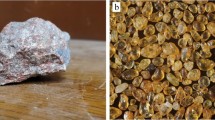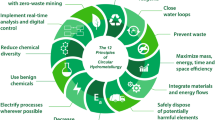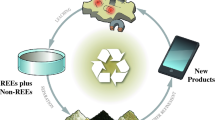Abstract
An approximate approach is described, making it possible to estimate without solving nonlinear equations describing the mass transfer of a multicomponent mixture in a quasi-ideal cascade, the maximum concentration of the intermediate target component which can be obtained in the product flux from the cascade. Asymptotic formulas are obtained for the range of existence of the solutions of the system of equations which relates the external and internal parameters of the cascade. The approach developed is illustrated by examples of a process of separation of a natural mixture of krypton isotopes in a quasi-ideal cascade for admissible concentrations of the target intermediate component in the product and waste flows.
Similar content being viewed by others
References
I. Yamamoto and A. J. Kanagawa, “Multicomponent isotope separation cascade composed of elements with large separation factors,” J. Nucl. Sci. Technology, 15(8), 28–32 (1978).
A. A. Sazykin, “Thermodynamic approach to isotope separation,” in: Isotopes. Properties. Production. Applications, V. Yu. Baranov (ed.), IzdAT, Moscow (2000), pp. 72–108.
G. A. Sulaberidze and V. D. Borisevich, “Cascades for separation of multicomponent isotope mixtures,” Sep. Sci. Technology, 36, No. 8/9, 1769–1817 (2001).
L. P. Kholpanov, G. A. Sulaberidze, D. V. Potapov, and V. A. Chuzhinov, “Multicomponent isotope separating cascade with losses,” Chem. Eng. Proc., 36, 189–193 (1997).
E. Halle, “Multicomponent isotope separation in matched abundance ratio cascades composed of stages with large separation factors,” in: Proc. of the 1st Workshop on Separation Phenomena in Liquids and Gases, Darmstadt, Germany, July 20–27, 1987, pp. 325–355.
H. Wood, V. D. Borisevich, and G. A. Sulaberidze, “On a criterion efficiency for multi-isotope mixture separation,” Sep. Sci. Technology, 34(3), 343–357 (1999).
V. D. Borisevich, G. A. Sulaberidze, and H. G. Wood, “The theory of isotope separation in cascades: problems and solutions,” Ars Sep. Acta, 2, 107–124 (2003).
V. P. Minenko, “Maximum enrichment of intermediate isotopes in the product from the ends of a cascade, ” At. Énerg., 33, No. 2, 704–706 (1972).
N. A. Kolokol’tsov, N. I. Laguntsov, and G. A. Sulaberidze, “On the choice of the optimal value of the concentration of a key isotope in the product of a cascade for separation of multicomponent isotopic mixtures,” At. Énerg., 35, No. 2, 127–128 (1973).
G. Korn and T. Korn, Handbook of Mathematics for Scientific Workers [Russian translation], Nauka, Moscow (1968).
D. Himmelblau, Applied Nonlinear Programming [Russian translation], Mir, Moscow (1975).
Author information
Authors and Affiliations
Additional information
__________
Translated from Atomnaya Énergiya,Vol. 100, No. 1, pp. 51–56, January, 2005.
Rights and permissions
About this article
Cite this article
Sulaberidze, G.A., Potapov, D.V., Borisevich, V.D. et al. Special features of the enrichment of components with intermediate mass in a quasi-ideal cascade. At Energy 100, 53–59 (2006). https://doi.org/10.1007/s10512-006-0049-9
Received:
Issue Date:
DOI: https://doi.org/10.1007/s10512-006-0049-9




